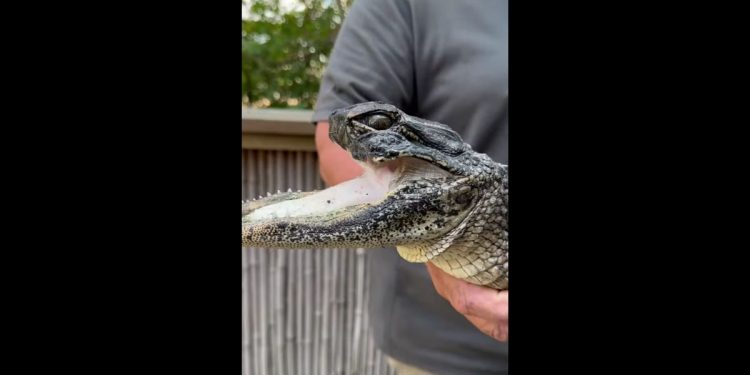When we think of alligators — even ones that haven’t reached maturity — we think of ruthless killing machines, reptiles whose formidable jaws can injure or kill almost any prey, including humans.
What we don’t think of them as is helpless. Yet, in Seminole County, Florida, people spent weeks searching for an immature female who would have been all but dead were it not for the intervention of animal lovers.
According to WESH-TV, the first reports of the injured animal came late last month at a park in Sanford, Florida called Wilson’s Landing.
“The picture of the alligator is hard to wrap your head around. It shows a gator with its snout torn or sliced off just below the eyeballs. With the top half of its jaw missing, you see most of the gator’s tongue,” the TV station reported.
The animal was found by an unidentified Seminole County woman.
“I think an image like this, missing the whole part of your face, is very shocking,” said Kim Titterington, a licensed wildlife rehabilitator.
WARNING: The following post contains graphic footage that some viewers will find offensive.
“We will never know who or what did this to the poor alligator. Some think the injury is from another gator; some think it’s from a propeller; I think it might a snare trap injury,” wrote Katrina Shadix, a director at the Foundation for Florida Environmental Protection, in a Facebook post in late August.
“When help arrived, the injured alligator jumped back into the water when they approached. The licensed HUMANE trapper went into the shallow water to try to get him, but then the gator swam into the larger, deeper part,” the post continued.
“This afternoon I messaged with Jerry, the only person in the Seminole County allowed to catch and possess any alligator,” she added. “FWC Law enforcement is handling this and went out twice today to look for the little gator.”
Titterington said that there were several reasons why the gator may have lost its upper jaw: a fight with another gator, a trap (as mentioned by Shadix) or a boat propeller. However, she told WESH she thought the propeller theory was unlikely because the gator would have heard the boat coming.
“Folks have put the word out on social media, trying to get the gator help. Trappers and, apparently, Florida Fish and Wildlife Conservation Commission officials have tried to catch it, but the gator is elusive,” WESH noted in its Sept. 8 report.
“Titterington says for now, the gator is feeding off bugs in the lake and whatever else it can suck in with half a jaw. But as it grows, Titterington fears that won’t be enough.”
Thankfully, on Friday, WESH was able to report the good news: “The search is over.”
“The little half-snout gator that’s been an internet sensation was caught by a trapper on Friday and now is in its forever home, Gatorland,” the station reported. “Gatorland Park Director Mike Hileman says the gator is living large.”
“We’ve moved her into her own little bungalow,” Hileman told the station regarding the injured gator.
Gatorland Orlando, which “rescues alligators and lets them live out their lives in our giant lakes,” welcomed its newest addition with a Facebook post of their own.
“She had basically no chance of surviving in the wild with such a severe injury. Here at Gatorland, our dedicated team will give her lots of loving care to live out her life in Alligator Paradise,” they said.
According to WOFL-TV, the alligator appears to be about four or five years old — about halfway to reaching maturity for the species.
“She looks like she had a hard time,” said Gatorland’s Savannah Boan.
“The trapper that actually snagged her was a gentleman named Jerry. And Jerry said he thought it might look like a propeller got her.”
The rescue service added that due to the amount of healing the wound from the severed jaw had undergone, Gatorland’s experts believe the reptile was living like that for at least six months, surviving on insects and small amphibians like snails and frogs.
“Alligators and crocodiles are amazing survivors,” Boan said. “They can survive almost anything.”
Granted, this gator hadn’t reached the size where it could kill almost anything — but it was getting there. Now, thanks to some of the humans that could have potentially been its prey, it will live out its days in something resembling comfort. Talk about a reversal of fortune.
This article appeared originally on The Western Journal.

























